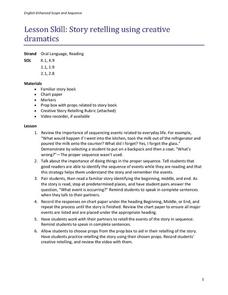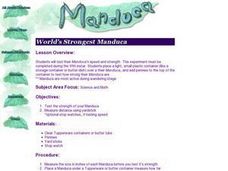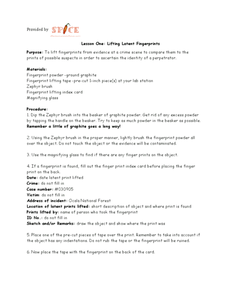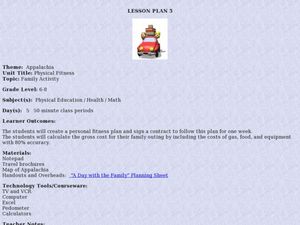Incredible Art Department
Story Tellers - "Passing on the Traditions"
It's important for young people to learn about their ancestry and the role of storytelling as a means of passing along traditions, information, and lessons. Based on what they already learned about Native American oral tradition,...
Curated OER
Weather Lesson
Students discuss the weather conditions. They read thermometer, rain gauge, barometer, and wind direction and speed. They record observations of weather conditions and enter information into data base on the computer.
Curated OER
Teaching the Musical Concept of Tempo
Intended for an Autism class, this lesson teaches self-expression through music while facilitating an understanding of the concept of tempo. Pupils engage in a call-and-response song, clap, discuss, and sing keeping feelings and...
Curated OER
Physical Fitness: Lesson number 2
Students are assessed on the amount of improvement they make over a period of 6 weeks. They keep track of their improvement on an Excel spreadsheet so they can also see their improvement. This lesson focuses on leg and arm strength.
Curated OER
Ocean Life: A Heavy Subject
Second graders examine The Learning Page Fact Files about ocean life and categorize the data by weight and group. They distinguish between fish, mammals, and invertebrates and which weigh the most and the least. Students record their...
Curated OER
Radish Seed Garden - Growth Data Table
Radishes are great plants to use in any unit on gardening. They are easy to germinate from seed. The worksheet has groups of gardeners plant two radish seeds in one container, and four radish seeds in another. They use this worksheet to...
Curated OER
Adaptation and Diversity on Sheffield Island
Written for an exploration of shoreline ecosystems on Sheffield Island, this gives ecology or marine biology buffs a hands-on experience. Using GPS or visual triangulation techniques, they lay transect lines on a high and a low energy...
Curated OER
Math: Working with Mayan Numbers
Students simulate a Mayan market place, and "purchase" items. They keep a record of their purchases and total number of beans left in their account. Students then convert the Mayan base system into the base ten system. This lesson...
Curated OER
Marble Mania
Students explore the concept of probability. In this probability lesson, students develop an understanding of probability by pulling marbles out of a bag and recording the data. Students use the recording sheet to discuss the results of...
Curated OER
One More/One Less Scoop
It's so simple: scoop a spoonful of counters, count them, and then make a set that is one more than that number. Next, make a set that is one less. The tangible nature of this basic addition and subtraction activity will keep learners...
Curated OER
Story Retelling Using Creative Dramatics
Doing things in the proper sequence is the focus of a solid language arts lesson. In it, pupils discuss the importance of doing things in the right order. Then, they pair off and read a short story together. They must retell the story to...
Novelinks
The House on Mango Street: Discussion Web
As part of a final discussion of The House on Mango Street, groups examine a concept question about the text, record arguments for and opposed to the question, and then a draw their own conclusions.
Curated OER
Poetry in Motion
Learners choose a poetry theme. They write a poem, illustrate it with digital images and record it using a digital video camera.
Curated OER
Your Day as a Cycle
Fourth graders examine a variety of cycles. They take a look at life cycles of plants and animals, the cycle of the moon and tides, and other sequences of events in their daily lives. An interesting part of the lesson is how kids keep...
Curated OER
World's Strongest Manduca
Middle schoolers test the strength and speed of their Manduca. They keep their insect in a small dish and wiegh it down with pennies. They share their observations with the class.
Curated OER
Lesson One: Lifting Latent Fingerprints
Crime scene investigators practice collecting fingerprints off of surfaces in order to compare them to an imaginary crime suspect's prints. Instructions for using graphite powder and a Zephyr brush to collect the evidence are outlined....
Curated OER
Mammals of the Deep Blue
Third graders study ocean mammals. They explore various websites and databases to answer questions and record answers about whales and dolphins. Finally they use the information obtained to write a report about them.
Curated OER
Gift of the Magi
While reading O Henry's "The Gift of the Magi," your class will define and identify situational irony and allusion. Use a study guide (not included, but easy to produce) to record and discuss examples of allusion as you read. Map the...
abcteach
What is Your Favorite Month?
A simple worksheet that helps learners conduct a survey is here for you. In it, pupils collect data on their family and classmate's favorite months. Youngsters use tally marks in the spaces provided to keep track of the answers. Once...
Curated OER
Get Off the Couch!
This 1-page worksheet provides space to record physical activity over the course of 5 days. It suggests documenting the activity and duration.
Curated OER
James Taylor: "You've Got a Friend"
Play James Taylor's song, "You've Got a Friend" to kickstart this lesson. After the initial play, encourage listeners to record the missing verbs in the lyrics provided. A word bank is included, but consider challenging your learners and...
Curated OER
Appalachia: Physical Fitness
Students plan a family fitness outing. For this physical education lesson, students will research possible physical activities which might be completed by a family during a daily-long outing in the Appalachian area. Students will...
Curated OER
Stepping Into Careers
In this career lesson, students take a look at the qualities a person must possess in order to be considered a "cooperative person." Students make a record of daily activities showing responsibility at school and home for a one week...
Curated OER
Logs, Charts, and Journals: What's On Your Plate?
Have your writers identify and use words that appeal to the senses. They create a chart of sensory words and record some of their favorites, then write a journal entry in which they describe eating at a restaurant using sensory details....























